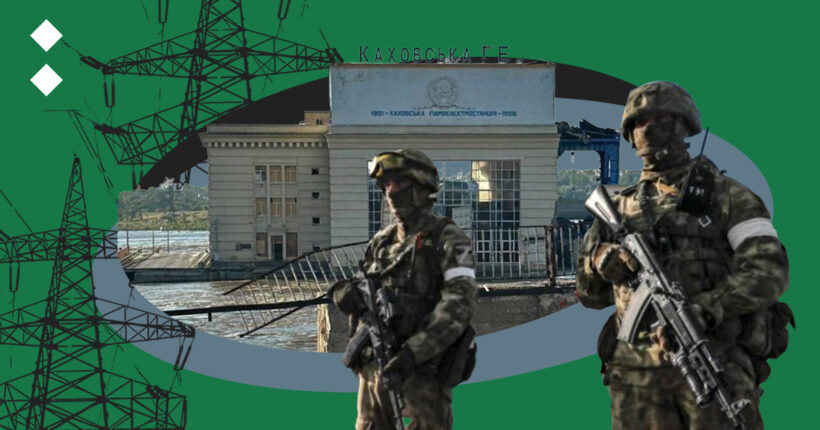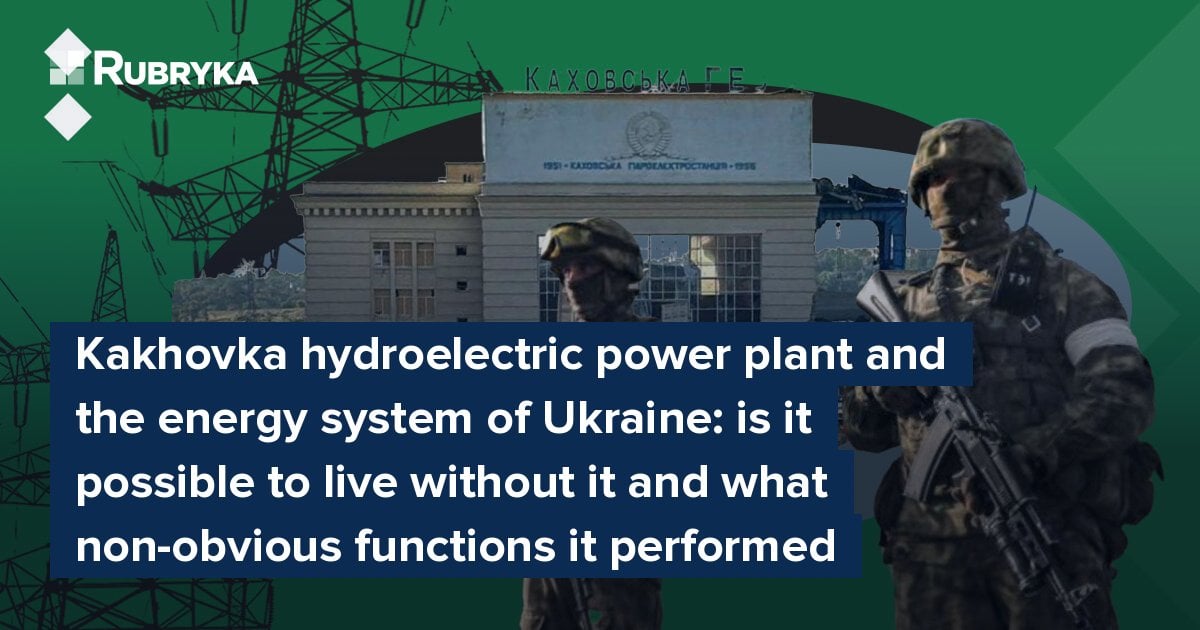
What is the problem?
On June 6, 2022, the Russian forces occupying Ukraine's Kherson region blew up the dam at Kakhovka Hydroelectric Power Plant (HPP), rendering it completely inoperable.

Consequences of undermining the Kakhovka HPP by the occupying forces of the Russian Federation. Photo from open sources
There has been a lot of discussion among Ukrainians about whether it is worth restoring the HPP. Environmentalists, hydropower engineers, and those who care have offered many alternative options, while Ukrhydroenergo, the largest hydropower generating company in Ukraine, is firmly determined to rebuild the Kakhovka HPP after the end of hostilities – the main argument being the need to provide electricity to the region.
Rubryka has already explored alternative options that could satisfy the needs of the population while also preserving the natural ecosystem, which has now begun to regrow on the exposed bottom of the Kakhovka Reservoir. However, the question of what role Kakhovka HPP will play in Ukraine's future energy system remains open.
In this article, we considered other non-obvious functions of the destroyed hydroelectric power plant and figured out what impact it had on the energy system of Ukraine.
What is the solution?
Is it possible to live without Kakhovka HPP?
The Kakhovka HPP, destroyed by the Russians, was one of Ukraine's eight active hydroelectric plants. Its maximum capacity was 334 megawatts. On average, the plant produced about one billion kilowatt hours of electricity annually. On the scale of the whole of Ukraine, this is a tiny amount — less than 1%.
The Kakhovka HPP's electrical contribution to the power system's energy balance was small. But the picture is different looking at the power balance. The maximum consumption of Ukraine in the winter before the war was about 24 gigawatts for several hours. The formally installed capacity of all power plants in the country was twice as much.
So, at when those 24 gigawatts were needed — and it wasn't every year — Ukraine couldn't do without importing from outside. "In other words, Kakhovka's contribution in terms of capacity is already twice as large. And if you take into account that water does not need to be 'mined' and is always available in the reservoir, then the role of the station increases even more. There is no need to talk about moments of missile attacks. It is difficult to overestimate the contribution of the HPP during the shelling of 2022 and to calculate it in percentages," explains energy expert Viktor Vizdigovskyi.

Kakhovka HPP destruction.
On the scale of the entire energy system, hydropower provides generation of a relatively small amount of electricity — only 5 to 10% of all consumption, but electricity from hydroelectric power plants is vital for balancing the entire energy system. If necessary, hydroelectric and gas power plants can significantly increase the amount of electricity production in a matter of minutes, covering peak load hours and helping maintain the power system in emergencies, for example, during enemy attacks on energy facilities.
"It is possible to live without the Kakhovka HPP, but it is necessary to understand what else will perform these functions of balancing and regulation," Vizdigovskyi summarized.
Since October 2022, the Kakhovka HPP has been offline. Therefore, the catastrophe of June 6 has not yet undermined Ukraine's power system in any way. At first, Ukrenergo announced this, and later, Ihor Syrota, the head of Ukrhydroenergo, confirmed it. But it should be remembered that consumption in Ukraine has almost halved.

Russian military on the Kakhovka HPP bridge, 2022. Photo: EPA/UPG
Can solar or wind power plants replace Kakhovskaya HPP?
Amid discussions about restoring the Kakhovka HPP, proposals were made to place solar stations on the bare bottom of the reservoir. However, they will not be able to replace HPP.
Now, there are a lot of solar and wind power plants, which worsens the situation with the balance of the energy system, says Vizdigovskyi.
"Earlier, energy companies had to produce electricity when there was consumption — to balance. Now, the situation is much more complicated since most of the generation is renewable. Wind and solar farms only work when there is wind or sun, respectively. Sometimes it coincides with the needs, and sometimes it doesn't. And someone must generate energy during these pauses and be ready to react to changes very quickly," he comments.
The energy engineer predicts that this can be done with the help of gas-fired thermal plants or hydroelectric plants, which played a big role because they balance the power system when there are fluctuations in consumption or changes in the generation of renewable energy.
In addition to balancing the energy system, the Kakhovka reservoir and hydroelectric power station performed several other functions: navigation and irrigation, water supply, and fishing. Irrigation became impossible after Russia's terrorist attack.
Many pumping stations were in an unserviceable condition even before the war, and now it turned out that pumping water at the level Ukraine has now is not so difficult. Water has already been supplied to Kryvyi Rih, and it can be done in other places as well. However, there was also another crucial function of the Kakhovka HPP — the regulation of the annual flow of the Dnipro.
Features that existed, but we didn't notice them
The daily flow of the Dnipro has a certain norm, but during the year, the flow level indicators can fluctuate by up to ten times greater or lesser than average. For example, in Kyiv, the flow has varied from 4150 liters per second to 128 over the past decades. The historical record is five times greater. The water flow below, where the Kakhovka reservoir was, is even greater since many rivers flow into the Dnipro further downstream. Reservoirs can significantly reduce these fluctuations, but not completely.
It turns out that this water can be contained, and there will not be such a big flood downstream in the Kherson region. However, reservoirs also have a maximum potential, and if it is exhausted, the water will have to be drained, which would certainly lead to flooding below Kakhovka dam.

Part of the river, located on the territory of the Kamianska Sich National Nature Park, is covered with meadow plants. Source: Serhii Skoryk
Today, if nothing is done at all and left as it is, fluctuations in the water level below Kakhovka could be significant. Of course, they cannot be compared to the flood that occurred after the hydroelectric power plant was blown up – but the water could still rise and cause damaging floods. After all, the construction for 70 years was carried out on the assumption that the HPP would continue regularly functioning.
Before the war, the World Bank considered a project to double the capacity of Kakhovka and to make some turbines able to work in pumping mode as well, as the Kyiv HPP can do. These additional capacities would make it possible to use "extra" water, which accumulates in some years. Such a reconstruction would significantly expand the station's ability to balance and regulate the power system. This was very important given the further development of renewable energy sources, which was planned for the future.
That is, says Vizdigovskyi, the dam should still be there so as not to flood settlements, fields, warehouses, and everything below Kakhovka.
"The solution can be an intermediate one, which will allow for navigation to be restored and raise the water level near the Dnipro HPP. However, even in this case, the dam may not be in the same place. All this requires additional calculations. The volume of the Kakhovka reservoir is about a third of the total volume of the entire Dnipro cascade. It is impossible to refuse this at the general meeting. Any real solution without restoring the Kakhovka HPP will be much more expensive and require a lot more time. This can become a world-class environmental project. The nearby famous Askania Nova Park confirms this is possible," says the expert.
So what are the options?
Ukrhydroenergo's plan has been widely criticized because the Environmental Impact Assessment (EIA) procedure will not be carried out during construction, and due to its rigidity and lack of alternatives.
Fourteen Ukrainian environmental protection non-governmental organizations joined the Kakhovska Platform coalition to develop alternative models of complex solutions for the restoration of the territories around the Kakhovka HPP.
The Kakhovska Platform has addressed the Prime Minister of Ukraine Denys Shmygal with a letter of application regarding the government's approval of the experimental project to rebuild the Kakhovka HPP.

Part of the river, located on the territory of the Kamianska Sich NPP, is covered with meadow plants. Source: Serhii Skoryk
In general, the authors of the letter emphasize the options can be divided into three groups:
- Rejection of reconstruction of the Kakhovka HPP and reservoir and restoration of the ecologically and historically important ecosystem of the Great Meadow in the closest to historical form. At the same time, the water supply issue is solved by transferring water intakes to the Dnipro River, reducing water consumption, and switching to resource-saving technologies in the agricultural sector and metallurgy. At the same time, there is a refusal to balance the energy system with the capacities of the Kakhovka HPP by replacing it with alternative options for energy generation and storage, and shipping is restored due to the improvement of the navigation characteristics of the Dnipro River.
- Restoration of the reservoir to its previous size and reconstruction of the Kakhovka HPP, most likely in a somewhat modernized version, as well as the accompanying infrastructure like water intakes and canals. Ukrhydroenergo is actively promoting this option.
- Other options of varying degrees of realism. For example, restoring the hydroelectric power station with a much smaller reservoir by damming the river channel and raising the water level only within its boundaries and rebuilding hydro-technical structures.
The prime minister's office has not responded to the letter, but the resonance in society and the proactive position of citizens is still expected to play a role. Ultimately, it is up to Ukrainians to decide whether Kakhovka HPP should exist and in what form.
The project "Restoration of the territories of southern Ukraine after the destruction of the Kakhovka reservoir" was created with the participation of the Center for Innovation (CFI), the French Agency for the Development of Mass Media, within the framework of the Hub Bucharest project, with the support of the Ministry of Foreign Affairs of France.








